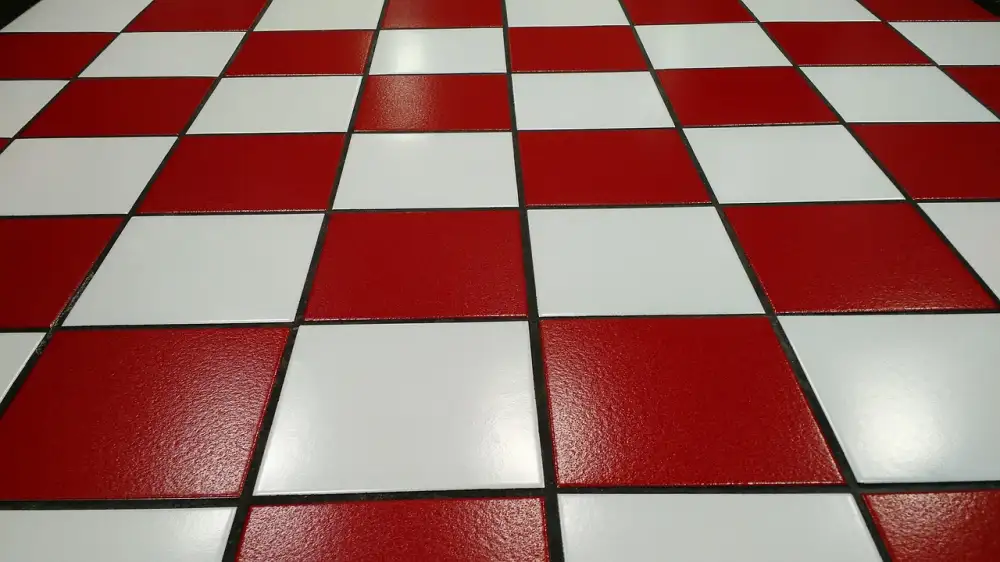Revive Your Tiles: A Step-by-Step Guide on How to Clean Grout

- Gather necessary supplies for cleaning grout
- Preparing the grout surface for cleaning
- Using a homemade grout cleaner
- Applying the grout cleaner to the grout lines
- Scrubbing the grout lines to remove dirt and stains
- Rinsing the grout lines with clean water
- Drying the grout lines thoroughly
- Applying a grout sealer for added protection
- Tips for maintaining clean grout
Grout is an essential component of any tiled surface, whether it's in your kitchen, bathroom, or outdoor patio. Over time, grout can become dirty and stained, detracting from the overall appearance of your tiles. Cleaning grout may seem like a daunting task, but with the right tools and techniques, you can revive your tiles and bring back their original beauty. In this step-by-step guide, we will walk you through the process of cleaning grout and restoring its pristine condition. Get ready to say goodbye to grimy grout lines and hello to sparkling tiles!
Gather necessary supplies for cleaning grout
To effectively clean grout, it is important to gather the necessary supplies beforehand. Here are the items you will need:
- Grout cleaner: You can choose between a store-bought cleaner or make your own using ingredients like baking soda, hydrogen peroxide, and dish soap.
- Scrub brush: Look for a brush with stiff bristles that can easily reach into the grout lines.
- Sponge or cloth: This will be used to wipe away excess cleaner and rinse the grout lines.
- Bucket of warm water: You'll need this for rinsing the grout lines after cleaning.
- Protective gear: Wear gloves to protect your hands from harsh chemicals and goggles to shield your eyes from splashes.
- Grout sealer (optional): If you want to provide extra protection to your newly cleaned grout, consider applying a grout sealer.
By having these supplies ready, you'll be well-prepared to tackle the task of cleaning your grout efficiently and effectively.
Preparing the grout surface for cleaning
Preparing the grout surface for cleaning is an important step to ensure effective results. Start by removing any loose debris or dirt from the grout lines using a soft brush or vacuum cleaner. Next, mix a solution of warm water and mild detergent. Apply this solution to the grout lines and let it sit for a few minutes to loosen any stubborn stains. For tougher stains, you may need to use a grout cleaner or a mixture of baking soda and water. Once the surface is prepped, you're ready to move on to the next step of cleaning the grout lines.
Using a homemade grout cleaner
Using a homemade grout cleaner is an effective and budget-friendly way to tackle those stubborn stains. To make your own grout cleaner, mix equal parts of baking soda and water to form a thick paste. This paste has natural cleaning properties that will help break down dirt and grime on the grout lines. You can also add a few drops of dish soap or vinegar for extra cleaning power. Once you have your homemade grout cleaner ready, it's time to move on to the next step: applying it to the grout lines.
Applying the grout cleaner to the grout lines
Once you have prepared the grout surface for cleaning, it's time to apply the grout cleaner to the grout lines. Start by pouring a small amount of the homemade grout cleaner onto a clean sponge or brush. Make sure to saturate the sponge or brush with the cleaner, but not to the point where it drips excessively.
Next, gently press the sponge or brush onto the grout lines, ensuring that each line is covered with the cleaner. Work in small sections at a time to prevent the cleaner from drying out before you have a chance to scrub.
Using circular motions, scrub the grout lines with moderate pressure. This will help loosen any dirt and stains that have accumulated over time. Pay extra attention to areas that are heavily soiled or discolored.
Continue applying and scrubbing the grout cleaner until all of the grout lines have been treated. If necessary, reapply more cleaner as needed.
Remember to work systematically and avoid rushing through this step. Take your time and ensure that each grout line receives adequate attention.
Once you have finished applying the grout cleaner, move on to the next step: scrubbing the grout lines to remove dirt and stains.
Scrubbing the grout lines to remove dirt and stains
To effectively remove dirt and stains from your grout lines, it's essential to scrub them thoroughly. Start by using a stiff-bristled brush or an old toothbrush. Dip the brush into the grout cleaner solution and begin scrubbing the grout lines in a back-and-forth motion. Apply some pressure to ensure you're reaching deep into the pores of the grout. Focus on areas with stubborn stains, giving them extra attention. Continue scrubbing until you see the dirt and stains start to lift off. Be patient and persistent, as this step may require some effort.
Rinsing the grout lines with clean water
After scrubbing the grout lines to remove dirt and stains, it is important to rinse them thoroughly with clean water. This step helps to remove any remaining grout cleaner residue and ensures that the grout lines are clean and ready for further treatment. Use a damp sponge or cloth to wipe away the cleaner from the grout lines, making sure to change the water frequently to avoid spreading dirt back onto the tiles. Continue rinsing until the water runs clear and there are no traces of cleaner left on the grout lines. This step is crucial in achieving sparkling clean grout that enhances the overall appearance of your tiles.
Drying the grout lines thoroughly
After rinsing the grout lines with clean water, it is important to dry them thoroughly. Leaving any moisture behind can lead to mold and mildew growth, undoing all your hard work. Start by using a clean, dry cloth to wipe away any excess water from the surface. Then, allow the grout lines to air dry for at least 24 hours before exposing them to any moisture or foot traffic. This will ensure that the grout is completely dry and ready for use. Remember, patience is key when it comes to drying grout – rushing this step may compromise your efforts in achieving clean and pristine grout lines.
Applying a grout sealer for added protection
Applying a grout sealer is an essential step to protect your freshly cleaned grout lines from future stains and dirt. Once the grout lines are completely dry, it's time to apply the sealer. Choose a high-quality grout sealer that is suitable for your specific type of grout.
Start by carefully reading and following the instructions provided by the manufacturer. Shake the sealer well before applying it to ensure proper mixing. Using a small brush or applicator, generously apply the sealer onto the grout lines, making sure to cover all areas.
Work in small sections at a time to ensure thorough coverage. Be careful not to let the sealer come into contact with any surrounding surfaces such as tiles or countertops, as it may cause discoloration or damage.
Allow the sealer to penetrate into the grout lines for the recommended amount of time specified by the manufacturer. This typically ranges from 5-15 minutes. During this time, avoid walking on or touching the sealed areas.
After the recommended time has passed, use a clean cloth or sponge to wipe away any excess sealer from the surface of the tiles. Make sure to remove all traces of sealer to prevent any residue from drying and leaving a hazy film on your tiles.
Allow the sealed grout lines to cure for at least 24 hours before exposing them to moisture or heavy use. This will ensure that the sealer fully sets and provides maximum protection.
Remember that regular maintenance is key to preserving your newly sealed grout lines. Clean spills promptly, avoid using harsh chemicals or abrasive cleaners, and periodically reapply a fresh coat of grout sealer as needed.
By applying a grout sealer, you can prolong the life of your clean grout and keep it looking fresh and vibrant for years to come.
Tips for maintaining clean grout
1. Regularly sweep or vacuum the tiled area to prevent dirt and debris from settling into the grout lines.
2. Wipe up spills immediately to prevent staining.
3. Avoid using harsh chemicals or abrasive cleaners on the grout, as they can damage the surface.
4. Use a mild soap and water solution for routine cleaning of the grout lines.
5. Consider using a grout sealer every 6-12 months to provide an extra layer of protection against stains and moisture.
6. Use a soft-bristle brush or toothbrush to gently scrub the grout lines periodically.
7. If you notice any cracks or damage in the grout, repair it promptly to prevent further deterioration.
8. Avoid dragging heavy objects across tiled surfaces, as this can cause damage to both the tiles and grout.
9. Place mats or rugs in high-traffic areas to reduce wear and tear on the grout lines.
10. Lastly, regularly inspect your grout for any signs of mold or mildew and address them immediately with appropriate cleaning solutions.
By following these simple tips, you can keep your grout looking clean and vibrant for years to come!
In conclusion, cleaning grout can be a tedious task, but the results are well worth the effort. By following this step-by-step guide, you can revive your tiles and bring back their original beauty. Remember to gather all the necessary supplies, prepare the grout surface, and use a homemade grout cleaner for effective results. Scrubbing and rinsing the grout lines will remove dirt and stains, while drying them thoroughly will prevent future mold or mildew growth. Applying a grout sealer will provide added protection and make future cleaning easier. Lastly, don't forget to maintain clean grout by regularly wiping down surfaces and addressing spills promptly. With these tips, your tiles will continue to shine for years to come!
Published: 20. 12. 2023
Category: Home



